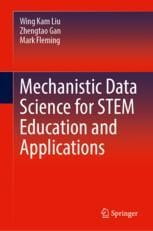MDS textbook - Mechanistic Data Science for STEM Education and Applications

This book introduces Mechanistic Data Science (MDS) as a structured methodology for combining data science tools with mathematical scientific principles (i.e., “mechanistic” principles) to solve intractable problems. Traditional data science methodologies require copious quantities of data to show a reliable pattern, but the amount of required data can be greatly reduced by considering the mathematical science principles. MDS is presented here in six easy-to-follow modules: 1) Multimodal data generation and collection, 2) extraction of mechanistic features, 3) knowledge-driven dimension reduction, 4) reduced order surrogate models, 5) deep learning for regression and classification, and 6) system and design. These data science and mechanistic analysis steps are presented in an intuitive manner that emphasizes practical concepts for solving engineering problems as well as real-life problems. This book is written in a spectral style and is ideal as an entry level textbook for engineering and data science undergraduate and graduate students, practicing scientists and engineers, as well as STEM (Science, Technology, Engineering, Mathematics) high school students and teachers.
US link to the textbook: https://www.springer.com/us/book/9783030878313#aboutBook
EU link to the textbook: https://www.springer.com/gp/book/9783030878313
Course overview
Mechanistic data science (MDS) is an emerging area that solves new and challenging problems by using known mathematical and scientific models to extract information from the torrent of data collected by the increasingly connected network of digital devices. MDS has wide-ranging applications, from computer vision to autonomous vehicles and tracking the spread of contagious viruses such as COVID-19.
This research-based course provides a deep dive into six data science topics including machine learning and deep learning. Expected takeaways include:
- Gain research experience from a mixture of classroom training and working with cross-functional
 teams
teams - Learn algorithmic thinking
- Receive an introduction to multiple STEM topics
- Appreciate the role and properties of data in scientific pursuits
- Springboard to future research or entrepreneurship
Machine learning is a subset of artificial intelligence using flexible algorithms that adapt to the available data, even when it is unstructured and heterogeneous. Highly scalable solutions for problems in object detection and recognition, text-to-speech conversion, and information retrieval are achievable through machine learning. Machine learning is taking center stage across physical and information disciplines of science, leading all these solutions to attain state-of-the-art performance when trained with large amounts of data. The concept of artificial intelligence is not new, however, the flood of data from connected networks combined with the increased computational power of common digital platforms have made these techniques feasible and accessible. In fact, marketers have recently commercialized and packaged machine learning tools for a variety of sectors ranging from banking to healthcare, not just engineering [1].
What we teach / What students learn
The course will be based on the to-be-published book entitled “Mechanistic Data Science for STEM Education and Applications,” written by Northwestern Professors Liu, Gan, and Fleming. This course will elucidate the integration of machine learning with engineering simulations or test data to reveal hidden physics that cannot be easily captured without otherwise requiring the use of multi-fidelity data.
We teach data-driven analysis, dimension reduction methods, reduced-order modeling, deep neural networks, and mechanistic machine learning (the scaffolding of data science algorithms using core scientific models from mathematics, physics, biology, chemistry, and mechanics) for engineering problems. We also demonstrate that mechanistic data science can be applied to almost any field of science and engineering to accelerate scientific and engineering discoveries. It will also be shown how MDS can be applied to other topics such as finance and marketing.
During the final course project, students from different backgrounds form a team, propose a project, take a deep dive into the scientific problems, and come up with tangible research outcomes. The final project will let the students move from classroom education to research environment by learning hands-on experience from their mentors Prof. Liu’s group.
Who takes the course?
High school students interested in data science, machine learning, and STEM education.
Undergraduate/graduate students with background knowledge in entry-level mathematics and science who are interested in performing research on the integration of data science and mathematical science.
Expected outcomes
High school students
- Gain a basic understanding of data science and machine learning
- Become excited about STEM education
Undergraduate students
- Gain expertise in data science and machine learning
- Learn research methodology in preparation for higher education
- Entrepreneurship
Graduate students
- Thorough research experience from problem definition to presentation of a research outcome.
